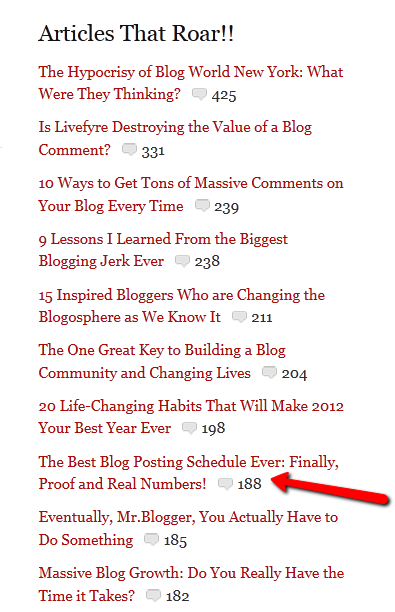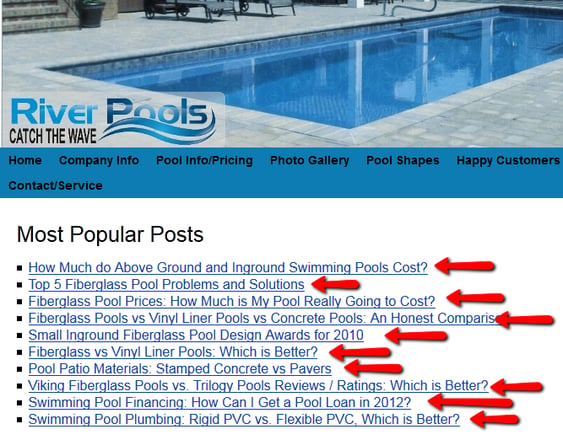Subscribe now and get the latest podcast releases delivered straight to your inbox.
Why a Popular Posts Widget may be a Bad Idea for Your Blog’s Sidebar

Nov 19, 2012

One of the most common “best practices” or suggestions you read about setting up a blog’s structure has to do with using a “popular posts” widget in the sidebar of your site—thus showing readers the most read/popular articles found on your blog since its beginning.
Sounds like a good idea, right?
Well, maybe, or maybe not.
Like everything else, it depends, which I’ll now explain.
Popular Posts Based on Comment Counts
Over the past year, I’ve had the following “popular posts” widget displaying in my sidebar. Like many do in the blogosphere, this display is based on the number of comments each article has received. Take a look:
 Although these articles have huge amounts of comments, how many would a potential TSL client find truly valuable and interesting?
Although these articles have huge amounts of comments, how many would a potential TSL client find truly valuable and interesting?
The obvious reason to put a widget like this in your blog’s sidebar is to show what other readers seem to respond to and resonate with, but going this route can have one major drawback—they do not always reflect your business goals and the type of client/customer you want to have.
I’m not sure if that makes sense, but let me explain my situation.
With The Sales Lion, it is my goal to attract two main types of clients:
- Companies that need help with their inbound and content marketing efforts with the goal of building their online brand and attracting more traffic, leads, and sales.
- Speaking opportunities.
If you look at this list of the 10 most commented articles in the history of The Sales Lion, how many would you say are targeting these types of clients? (Seriously, look back at the list and think about it for a second, you may be very surprised.)
In my opinion, the only post that could possibly help my clients of today is the blog post scheduling article, which is designated with a red arrow.
The rest, although they may have received a HUGE response, simply don’t speak to my client-base today.
I’m not saying here that those articles don’t have value and don’t help certain individuals, but most were written during a period of The Sales Lion when I really didn’t know what the business goals of this site were—as my main goal at the time was simply to attract readers by writing good stuff.
There was nothing wrong with those goals then, but they weren’t a business model, and certainly aren’t going to pay the bills.
Swallowing My Pride
Over the past few months, every time I’ve looked at those articles in the sidebar I kept asking myself the same question:
“If a 50 million-dollar company stumbles upon my blog and immediately starts reading all these ‘popular posts’—are they going to get a better sense of the value I’d bring to their organization?”
My answer, as I’m sure you already know, was “NO.”
And if I’m being honest with myself, I think the only reason I may have left them up there that long was to show new visitors how many comments people had left on my blog. In other words, like many times in my life, pride was getting in the way of intelligent strategy and best results.
Page Views as a Leading Indicator
This being said, some of you may be asking if, instead of a popular posts widget that uses comments as the leading indicator, why wouldn’t we use “page views” as the key metric—something that is offered by certain widgets/plugins that you can easily install on your blog’s sidebar.
But like before, the answer would be, “It depends.”
Here is the thing—if you feel like the most-viewed pages (articles) on your blog represent your ideal client, then by all means, show them. Put them out there for the world to see.
But if you don’t feel strongly about them because they aren’t truly targeting your end-user/ideal customer, then I wouldn’t include the list, and instead would come up with a set of articles/links that you feel your clients would be best served reading.
In the case of my swimming pool company, the “most popular posts” widget is perfect for my client base—those persons serious about buying a fiberglass pool. In fact, here is a screen shot of the top 10 blog posts on my swimming pool website, with a red arrow indicating it has significant value for our target audience.
Frankly, the main reason why the River Pools popular posts display is so much better than what I would have here at TSL is because, at River Pools, we’ve had a clear focus for quite some time as to who we are and what we want to teach our clients about—whereas The Sales Lion (as a content marketing/speaking brand) is just starting to truly take off these last 10 months or so.
Hopefully you understand the point of this article. In fact, now that I think about it, the title really didn’t need to be just about popular posts at all, but more about the messaging we want to send to our web visitors and readers.
When it comes down to it, you have to ask the following question with every piece of information/article you display on your website:
Will showing this help me generate more trust, leads, clients, and sales?
If you allow that simple question to be your guiding light going forward, there is a good chance the positive results will follow.
Your Turn:
I’m really curious to hear your thoughts on this subject. Do you have a popular post widget displayed on your blog? Do you feel it accurately represents the customers you’re targeting? And what guides you as to the main information you display on your website?
Free: Assessment
